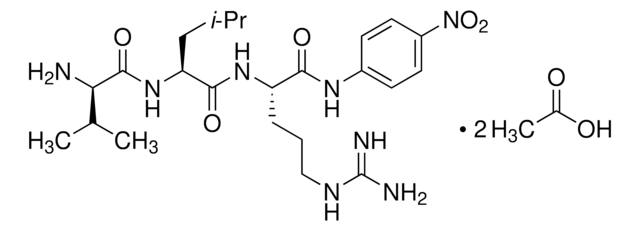Wszystkie zdjęcia(1)
Kluczowe dokumenty
About This Item
Wzór empiryczny (zapis Hilla):
C6H14N2O
Masa cząsteczkowa:
130.19
Numer MDL:
Kod UNSPSC:
12352200
Identyfikator substancji w PubChem:
Polecane produkty
opis
AldrichCPR
Formularz
solid
ciąg SMILES
O=C(C)NCCCCN
InChI
1S/C6H14N2O/c1-6(9)8-5-3-2-4-7/h2-5,7H2,1H3,(H,8,9)
Klucz InChI
KLZGKIDSEJWEDW-UHFFFAOYSA-N
Inne uwagi
Należy pamiętać, że Sigma-Aldrich dostarcza ten produkt badaczom zajmującym się wczesnymi odkryciami jako część kolekcji unikalnych chemikaliów. Sigma-Aldrich nie gromadzi danych analitycznych dla tego produktu. Kupujący ponosi odpowiedzialność za potwierdzenie tożsamości i/lub czystości produktu. Wszystkie transakcje sprzedaży są ostateczne.
NIEZALEŻNIE OD JAKICHKOLWIEK POSTANOWIEŃ PRZECIWNYCH ZAWARTYCH W STANDARDOWYCH WARUNKACH SPRZEDAŻY FIRMY SIGMA-ALDRICH LUB UMOWIE ZAWARTEJ MIĘDZY FIRMĄ SIGMA-ALDRICH A KUPUJĄCYM, FIRMA SIGMA-ALDRICH SPRZEDAJE NINIEJSZY PRODUKT "TAKI, JAKI JEST" I NIE SKŁADA ŻADNYCH OŚWIADCZEŃ ANI NIE UDZIELA ŻADNYCH GWARANCJI W ODNIESIENIU DO TEGO PRODUKTU, W TYM ŻADNYCH (A) GWARANCJI PRZYDATNOŚCI HANDLOWEJ, (B) GWARANCJI PRZYDATNOŚCI DO OKREŚLONEGO CELU LUB (C) GWARANCJI NIENARUSZANIA PRAW WŁASNOŚCI INTELEKTUALNEJ OSÓB TRZECICH, NIEZALEŻNIE OD TEGO, CZY WYNIKA TO Z PRZEPISÓW PRAWA, PRZEBIEGU TRANSAKCJI, SPOSOBU DZIAŁANIA, ZWYCZAJU HANDLOWEGO LUB W INNY SPOSÓB.
NIEZALEŻNIE OD JAKICHKOLWIEK POSTANOWIEŃ PRZECIWNYCH ZAWARTYCH W STANDARDOWYCH WARUNKACH SPRZEDAŻY FIRMY SIGMA-ALDRICH LUB UMOWIE ZAWARTEJ MIĘDZY FIRMĄ SIGMA-ALDRICH A KUPUJĄCYM, FIRMA SIGMA-ALDRICH SPRZEDAJE NINIEJSZY PRODUKT "TAKI, JAKI JEST" I NIE SKŁADA ŻADNYCH OŚWIADCZEŃ ANI NIE UDZIELA ŻADNYCH GWARANCJI W ODNIESIENIU DO TEGO PRODUKTU, W TYM ŻADNYCH (A) GWARANCJI PRZYDATNOŚCI HANDLOWEJ, (B) GWARANCJI PRZYDATNOŚCI DO OKREŚLONEGO CELU LUB (C) GWARANCJI NIENARUSZANIA PRAW WŁASNOŚCI INTELEKTUALNEJ OSÓB TRZECICH, NIEZALEŻNIE OD TEGO, CZY WYNIKA TO Z PRZEPISÓW PRAWA, PRZEBIEGU TRANSAKCJI, SPOSOBU DZIAŁANIA, ZWYCZAJU HANDLOWEGO LUB W INNY SPOSÓB.
Ta strona może zawierać tekst przetłumaczony maszynowo.
Hasło ostrzegawcze
Warning
Zwroty wskazujące rodzaj zagrożenia
Zwroty wskazujące środki ostrożności
Klasyfikacja zagrożeń
Acute Tox. 4 Oral
Kod klasy składowania
11 - Combustible Solids
Temperatura zapłonu (°F)
Not applicable
Temperatura zapłonu (°C)
Not applicable
Wybierz jedną z najnowszych wersji:
Certyfikaty analizy (CoA)
Lot/Batch Number
It looks like we've run into a problem, but you can still download Certificates of Analysis from our Dokumenty section.
Proszę o kontakt, jeśli potrzebna jest pomoc Obsługa Klienta
Masz już ten produkt?
Dokumenty związane z niedawno zakupionymi produktami zostały zamieszczone w Bibliotece dokumentów.
Dharamdeep Jain et al.
Biomacromolecules, 19(7), 3048-3057 (2018-06-14)
The aggregate glue in spider webs is composed of hygroscopic low molecular mass compounds (LMMCs), glycoproteins and water. The LMMCs absorb atmospheric water and solvate the glycoproteins to spread and adhere to flying insects upon contact. The glue viscosity varies
Jose C Fernandez-Garcia et al.
Journal of clinical medicine, 8(1) (2019-01-13)
Objective: Polyamines are naturally occurring cationic molecules present in all living cells. Dysregulation of circulating polyamines has been reported in several conditions, but little is known about the levels of serum polyamines in chronic metabolic disorders such as type 2
Iris Samarra et al.
Biomolecules, 9(12) (2019-11-30)
Polyamines are involved in the regulation of many cellular functions and are promising biomarkers of numerous physiological conditions. Since the concentrations of these compounds in biological fluids are low, sample extraction is one of the most critical steps of their
Bastien Labarrere et al.
Plants (Basel, Switzerland), 8(7) (2019-07-25)
Plants produce a high diversity of metabolites which help them sustain environmental stresses and are involved in local adaptation. However, shaped by both the genome and the environment, the patterns of variation of the metabolome in nature are difficult to
Yang Hai et al.
Nature communications, 8, 15368-15368 (2017-05-19)
Cationic polyamines such as spermidine and spermine are critical in all forms of life, as they regulate the function of biological macromolecules. Intracellular polyamine metabolism is regulated by reversible acetylation and dysregulated polyamine metabolism is associated with neoplastic diseases such
Nasz zespół naukowców ma doświadczenie we wszystkich obszarach badań, w tym w naukach przyrodniczych, materiałoznawstwie, syntezie chemicznej, chromatografii, analityce i wielu innych dziedzinach.
Skontaktuj się z zespołem ds. pomocy technicznej







